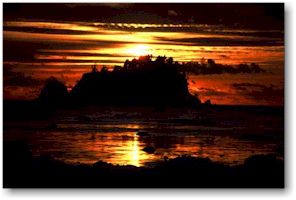Olympic National Park
History | Sightseeing | Area Information | Ecology | Hiking | Camping | Wilderness Adventures | Additional Images
|
|
|
| Description
Often referred to as "three parks in one", Olympic National Park encompasses three distinctly different ecosystems—rugged glacier capped mountains, over 60 miles of wild Pacific coast and magnificent stands of old-growth and temperate rain forest. These diverse ecosystems are still largely pristine in character (about 95% of the park is designated wilderness) and are Olympic's gift to you. Olympic is also known for its biological diversity. Isolated for eons by glacial ice, the waters of Puget Sound and the Strait of Juan de Fuca, the Olympic Peninsula has developed its own distinct array of plants and animals. Eight kinds of plants and five kinds of animals are found on the peninsula and live nowhere else in the world.
|
Park Information
Hours/Seasons: The park itself is open 24 hours a day, 365 days a year. Most roads remain open year round, although several are subject to winter closure because of snow. Some campgrounds are open year round, while others close for the winter. Visitor center hours vary throughout the year. It is best to contact the park for current information. Directions: From the Seattle/Tacoma area, travelers may reach U.S. 101 by several different routes, either by crossing Puget Sound on one of the Washington State Ferries or by driving south around Puget Sound. Travel time along any of these routes is approximately two-and-a-half to three hours from the Seattle/Tacoma area to Port Angeles, where the main park visitor center and park headquarters are located. All major rental companies serve the SeaTac Airport. Rental cars are also available on the Olympic Peninsula in Port Angeles, Sequim and Grays Harbor. Fees: Weather: Olympic has a moderate marine climate with pleasant summers and mild, wet winters. Summers are generally fair and warm, with high temperatures usually between 65 and 75 degrees F. Summer is the driest season, with heavier precipitation during the rest of the year. Winters are mild, with temperatures at lower elevations in the 30's and 40's.
|
|||
|
History
American Indians have lived here for thousands of years, both along the coast and in the interior reaches of the peninsula. Their primary form of subsistence came from the sea and rivers, as well as berries, roots, and land mammals. Cedar was the most important material resource, used for everything from house planks to canoes. The bark was used for clothing and baskets, even towels and diapers. In 1592, the first European, Juan de Fuca, may have come along these shores. Reliable information of European penetration, however, is not available until 1774 when Juan Perez sailed along this coast. In the next 25 years a bevy of British, American, and Spanish explorers visited the area. The most enduring work was done by Robert Gray, an American, and George Vancouver, an Englishman. Both men explored the area thoroughly, establishing rival claims to this land for their own countries. Although American Indians utilized and traveled throughout the mountains of the peninsula, it was not until 1885 that the first systematic documented exploration of the interior of the Olympic Peninsula was made. That year Lt. Joseph P. O'Neil led the first documented expedition into the interior. In 1889-90 the Press expedition led by James Christie made a north-south crossing in five and one-half months. In 1890 Lt. O'Neil returned and made an east-west crossing. Slowly a movement got underway to set aside some of the peninsula as a national park. In 1897 President Grover Cleveland created the Olympic Forest Reserve, a portion of which President Theodore Roosevelt designated a national monument in 1909. In 1938, President Franklin D. Roosevelt signed legislation creating Olympic National Park and in 1988 nearly 96 percent of the park was designated as wilderness. Olympic is a place for the soul to expand and for the mind to be refreshed with the beauty of life. |
||||
|
For Additional Information Contact: Olympic
National Park Visitor
Center 360-565-3130 For more information visit the National Park Service website |
||||


 Olympic
National Park welcomes you to a diverse and stunning world--a fog-shrouded
coast with booming surf and wave-manicured beaches, spectacular alpine
country dotted with sparkling lakes, lush meadows, glaciers, and North
America's finest temperate rain forest.
Olympic
National Park welcomes you to a diverse and stunning world--a fog-shrouded
coast with booming surf and wave-manicured beaches, spectacular alpine
country dotted with sparkling lakes, lush meadows, glaciers, and North
America's finest temperate rain forest.